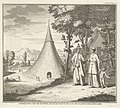ဗွိုက်လတက်မန် ခေတ်အဆက်ဆက်
ဗွိုက်လတက် ကေုာံ ကယျိုင်ကယျဝ်မန် ခေတ်အဆက်ဆက် (Costume and fashion in Mon through the Ages) ဝွံ ဒှ်လိက်ပရေင် မပကောံချူလဝ် မဆေင်ကဵု ဗွိုက်လတက် ကေုာံ ကယျိုင်ကယျဝ်မန် နူကဵုခေတ်တြေံ စဵုကဵု ခေတ်လၟုဟ်။ ပ္ဍဲကဵု မဗမံက်ထ္ၜး ဗွိုက်လတက်မန် ခေတ်နာနာဝွံ သီုဗၟံက်ထ္ၜးဏာ ဝင်ဂကူမန်ကီုဟေင် ဍိုက်ပေင်ကၠိုဟ်ကေတ်မာန်ရ။
ခေတ်တမၠာ
[ပလေဝ်ဒါန် | ပလေဝ်ဒါန် တမ်ကၞက်]ဂကူမန်တအ် ပြံင်လုပ်ကၠုင် နူရးနိဂီုကြုက် ပ္ဍဲဒေသအေန်ဒဝ်ချာင်နာ ပ္ဍဲသၞာံၜိုတ် ၃၀၀၀ ဘဳသဳ မဒှ်မာန်ရ။[၁] ပၞောဝ်ကဵု ဂကူရးတၞံဂမၠိုင် မစိုပ်ကၠုင် ပ္ဍဲတိဇမၞော်အာရှအဂၞဲဂှ် ဂကူမန်ဂှ် လုပ်လၟိဟ် ညးမစိုပ်ကၠုင် ကိုပ်ကၠာအိုတ်မွဲတၠရ။ ဂကူမန်တအ် ခၞံဗဒှ်ပတိုန် ဂကောံမၞိဟ်ကိုပ်ကၠာအိုတ် ပ္ဍဲကဵုဒေသဂှ်တုဲ ပၞောဝ်ကဵု ဂကောံမၞိဟ် ဂကူမန်တအ် မဒက်ပ္တန်လဝ်ဂှ် ရးနိဂီုဒွါရဝတဳ မဒှ်ဒၞာဲ ဗဟဵုလဒေါဝ်ရးနိဂီုသေံ သီုကဵု ဒေသဨသာန်၊ သြဳဂေါတပူရ မဒှ်ဒေသ လဒေါဝ်ရးနိဂီုလဴ (ခေတ်လၟုဟ် ညးကော်စ သဳခေါတ်တဗောန် Sikhottabong)၊ ဝဳယေန်ကျေန်) ကေုာံ ဒေသဨသာန်ရးနိဂီုသေံ၊ ရးနိဂီုဟာရိဘုဉ္ဇယ မနွံဒေသသၟဝ်ကျာရးနိဂီုသေံ ကေုာံ ရးနိဂီုသုဝဏ္ဏဘုမ္မိ မနွံ ပ္ဍဲရးနိဂီုဗၟာသကုတ်သၟဝ်ရ။ ပ္ဍဲဒေသရးနိဂီုဗၟာ သကုတ်လဒေါဝ်ဂှ် ဗွဲတၟေင် ပ္ဍဲဒေသ ကျောက်ဆည်ဂှ် ဂကူမန်တအ် ပတန်လဝ် ဂကောံမၞိဟ် ကိုပ်ကၠာအိုတ်ရ။[၂] ဂကောံမၞိဟ်မန် ပ္ဍဲဒေသရးနိဂီုဗၟာ သကုတ်လဒေါဝ်ဂှ် ဂကူမန်တအ် ဒက်ပ္တန် ဍုင်ဗုကာံ သၟိင်ယၟုမြဟ် မၞိဟ်မတီဂၠိုင်အိုတ်ဂှ် သၟိင်အနုရုဒ္ဓ (အနဝ်ရထာ)၊ သၞာံ ၁၀၇၉ သၟိင်ဗဇြဘရဏဒေဝ ပကင်ရင် ဍုင်ဗုကာံ၊ ပ္ဍဲသၞာံ ၁၀၈၄ဂှ် အဝဵုဍုင်ဂှ် ဒးဒုင်သီ ကဵုသကိုပ်ပၞာန်ဂကူဗၟာတုဲ သကိုပ်ပၞာန်ဂှ် အခိင်ကာလ ညးမဒှ်သၟိင်ဂှ် ကလိဂွံ မဟိမုတြိဘုဝနာဒိတျဓမ္မရာဇ။ သၟိင်ဗဇြဘရဏဒေဝဂှ် ဒှ်သၟိင်မန် လက်ကြဴအိုတ် ပ္ဍဲဒေသရးနိဂီုဗၟာ သကုတ်လဒေါဝ်ရ။ သၟိင်တြိဘုဝနာဒိတျဓမ္မရာဇဂှ် ဒှ်သၟိင်ဂကူဗၟာ ကိုပ်ကၠာအိုတ်ရ။ လက်ထက်သၟိင်ဏအ်ဂှ် အဝဵုသြဇာဗုကာံ စှ်ေစိုပ်ကၠုင် စဵုကဵု ဒေသရးနိဂီုဗၟာ လပါ်သၠုင်ကျာ စဵုကဵု ထဝါဲရ။[၃]
တၞဟ်န မဂွံစၟတ်သမ္တီလောဲတုဲ ဂကောံမၞိဟ်ဂကူမန် ပ္ဍဲခေတ်တမၠာ မပတန်လဝ် ပ္ဍဲဒေသ မကော်စလၟုဟ် ရးနိဂီုသေံ ကဵု ရးနိဂီုလဴဂှ် ကော်စ မန်ဒွါရဝတဳ၊ တုဲ ပ္ဍဲဒေသ မကော်စလၟုဟ် ရးနိဂီုဗၟာ လဒေါဝ် ကဵု သၟဝ်ဂှ် ကော်စ မန်ရာမညဒေသ။ ဂကူမန်ၜါဝွံ ၜိုန်ရ ဒေသတိဍာ် သ္ၚောဲတၞဟ်ခြာတဴဒၟံင်ကီုလေဝ် ဟိုတ်နူသီုၜါဂှ် ယေန်သၞာင်အခိုက်အိန္ဒိယ မလုပ်စိုပ်ဒၟံင် လှဲလှဲလးလးတုပ်တုဲ စပ်ကဵု ဗွိုက်လတက်လေဝ် ကြပ်ညောန် ရေင်သကအ် ဗွဲမလောန်ရ။ ယေန်သၞာင်မန်ဒွါရဝတဳဂှ် ဟိုတ်နူ သၟာပုရာန်သေံတအ် ၜံက်ခါဲဂိုင်ဒေပ် ထ္ၜးပျးလဝ် ပ္ဍဲတိုက်ထ္ၜးပျး နဒဒှ် အာဲကၟာဲယေန်သၞာင်ဍုင်မွဲတုဲ ဗွဲမလှဲလး ပိုယ်တအ် လ္ၚတ်ကေတ်မာန်ရ။
ကယျိုင်ကယျဝ်မန် ဒွါရဝတဳ သၟိင်တၠ
[ပလေဝ်ဒါန် | ပလေဝ်ဒါန် တမ်ကၞက်]ကယျိုင်ကယျဝ်သၟိင်တၠတအ်ဂှ် ပါဲနူ ဗွိုက်လတက်ယာတ်တုဲ ကပေါတ်ဗြံက်ဗြဂမၠိုင် မပ္တံကဵု ၝောအ်ကိုဋ် (အရာမဂလဝ်စုတ် လတူကၞိပ်)၊ ဗြကၞေင် (အရာမခၠိုင်စုတ် ပ္ဍဲကၞေင်)၊ လက်ကြာပ် (အရာမကြာပ်စုတ် ပ္ဍဲခဒအ်တဲ)တအ်လေဝ် နွံကီုရ။
ၝောအ်ကိုဋ် ဨကရာဇ်
[ပလေဝ်ဒါန် | ပလေဝ်ဒါန် တမ်ကၞက်]ၝောအ်ကိုဋ် ဨကရာဇ်မန် ခေတ်ဒွါရဝတဳဂှ် ဂွံဆဵုကေတ် ၜါဗီု၊ (၁) မနွံဗီုပြင် လမဳ မဂါပ်ဂလဝ်စုတ် လတူက္ဍိုပ် သကုတ်လတူ ပ္ဍဲကၞေင် လတူကတောဝ်။ ၝောအ်ကိုဋ်ဂှ် နွံကဵု ဂရီု (ဒၞာဲဗွဲသၟဝ်ဂှ် (ဝါ) ဒၞာဲပါင်ၝောအ်ကိုဋ်ဂှ် နွံကဵု ဍောင်ကနုပကဴ ရေင်မတ်၊ ဒၞာဲလဒေါဝ်ကၞေင်ဂှ် နွံကဵု ဍောင်ဇၞော်ဇၞော်မွဲမ။ နူကဵု ဂရီုဂှ် နွံကဵု ဂစေဟ်ဍောတ်တ် ဗီုပြင်တၞးကြေင်မွဲဒကုတ် ထ္ၜောမ်ဍောတ်စှ်ေ ဗွဲလတူ။ (၂) ဗီုပြင်တုပ် ကဵု ဗီု(၁) ဆဂး ကေက်ဂၠိုင်တုဲ ပါ်လဝ် ဘုံ။
 |
 |
| (၁) ရုပ်ၝောအ်ကိုဋ်မန် ခေတ်ဒွါရဝတဳ ၜိုတ် ၉ ဗွဝ်ကၠံ၊ နူနခေါန်ပထုံ |
(၂) ရုပ်ၝောအ်ကိုဋ်မန် ခေတ်ဒွါရဝတဳ ၜိုတ် ၉ ဗွဝ်ကၠံ၊ နူနခေါန်ပထုံ |
ကၟက်ကအ် ဨကရာဇ်
[ပလေဝ်ဒါန် | ပလေဝ်ဒါန် တမ်ကၞက်]ကယျိုင်ကယျဝ် သၟိင်တၠ ဗီုကဵု ဨကရာဇ် ခေတ်ဒွါရဝတဳ မွဲပၠန်ဂှ် ဇုက်ကၞက်ကအ် မနွံကဵု ကိရိယာ (locket) ဇၞော်ဇၞော် လဒေါဝ်ကောန်သြိုဟ်။

|

|
| (၁) ဗီုရုပ်သၟိင်တၠ (ဗောဓိသတ်ဒှ်မာန်) ထ္ၜးလဝ် ပ္ဍဲတိုက်ထ္ၜး ပရပထုံ |
(၂) ဗီုရုပ်သၟိင်တၠ (ဗောဓိသတ်ဒှ်မာန်) ထ္ၜးလဝ် ပ္ဍဲတိုက်ထ္ၜး ပရပထုံ |
ကယျိုင်ကယျဝ် ညးဍုင်ကွာန်
[ပလေဝ်ဒါန် | ပလေဝ်ဒါန် တမ်ကၞက်]ကယျိုင်ကယျဝ် ညးဍုင်ကွာန် မန်ခေတ်တြေံ ဒွါရဝတဳဂှ် ကယျိုင်ညးဗြဴ ကဵု ကယျိုင်ညးတြုဟ် ၜါဏအ် ပိုယ်ပါ်ဂွံရ။ ဗွဲတၟေင် ကယျိုင်က္ဍိုပ် ဗီုမစွံသော်၊ ဗွိုက်လတက်ဂမၠိုင် မပ္တံကဵု ပလောအ်၊ ဂၠိက်၊ ဂၞိန်။
ကယျိုင်က္ဍိုပ်/သော်
[ပလေဝ်ဒါန် | ပလေဝ်ဒါန် တမ်ကၞက်]ရံင်ကဵု ရုပ်သၟာဂဳတညးဗြဴမသုန် မဂွံဆဵုကေတ် နူကုဗဴ (Ku Bua) မဒှ်ရုပ် နူကဵု အကြာ ၆၅၀ - ၇၀၀ အေဒဳ ဂှ် ကဵု ရုပ်ညးဗြဴဂမၠိုင် မဂဇအ်ဒၟံင် ပ္ဍဲတိုက်ထ္ၜးပျး ပရပထုံတုဲ ညးဗြဴမန် ခေတ်ဒွါရဝတဳတေအ်ဂှ် ညးတအ် စွံသော်ဂၠိင်င်တုဲ ပ္ဍဲအခိင်ဓမ္မတာမ္ဂး သီလဝ်တုဲ စန်လဝ် လပါ်လက်ကြဴ။ အခိင်ကာလ မတိုန်သဘင် မဒးထ္ၜးပျးမွဲမွဲမ္ဂး ထကတ်သော်ယံင် လတူက္ဍိုပ်။ သော်ယံင်တအ်ဂှ် လ္ၚဵုနွံဂၠိုင်ကဵု ဘုံ။

|

|
| (၁) ဗီုရုပ်သၟာဂဳတမန် ဒွါရဝတဳ နူကုဗဴ |
(၂) ဗီုရုပ်ညးဗြဴဂမၠိုင် ထ္ၜးလဝ် ပ္ဍဲတိုက်ထ္ၜး ပရပထုံ |
ဒွါရဝတဳ
-
Thailand, Ku Bua, (Dvaravati culture), 650-700 C.E. Sculpture with influences from India. Three musicians in right are playing (from center) a 5-stringed lute, cymbals, a tube zither or bar zither with gourd resonator.
-
Head of a Male Figure 8th–9th century Thailand (Ratchaburi Province, Ku Bua) On view at The Met Fifth Avenue in Gallery 246. In Thailand, stupas and temples were often embellished with terracotta and stucco sculptures. In some instances, even large-scale narrative friezes illustrating stories from the Buddha's life survive. In contrast to the stone and metal images that served as the primary objects of worship, these sculptures in plastic media show a greater degree of spontaneity and freedom of expression.
-
Title: Head of a Male Deity, Period: Mon-Dvaravati period, Date: ca. 9th century, Culture: Thailand (probably Nakhon Pathom Province), Medium: Stucco
-
Among the stuccos recovered from various ancient sites in Nakhon Pathom, there is a type with tiered conical headdress consisting of many triangular elements. This head was probably made in Nakhon Pathom. It and related heads may have originally belonged to figures flanking the Buddha.
-
thumb
-
thumb
-
thumb
-
thumb
-
Dvaravati period stucco. Phra Pathom Chedi National Mseum (พิพิธภัณฑสถานแห่งชาติ พระปฐมเจดีย์)
-
Dvaravati period stucco. Phra Pathom Chedi National Mseum (พิพิธภัณฑสถานแห่งชาติ พระปฐมเจดีย์)
-
Dvaravati period stucco. Phra Pathom Chedi National Mseum (พิพิธภัณฑสถานแห่งชาติ พระปฐมเจดีย์)
-
Dvaravati period stucco. Phra Pathom Chedi National Mseum (พิพิธภัณฑสถานแห่งชาติ พระปฐมเจดีย์)
-
Dvaravati period stucco. Phra Pathom Chedi National Mseum (พิพิธภัณฑสถานแห่งชาติ พระปฐมเจดีย์)
ဗဂေါ
-
thumb
-
thumb
-
thumb
-
thumb
-
thumb
-
thumb
-
thumb
-
thumb
-
thumb
-
between 1620 and 1664
-
thumb
-
1888, I 334 THE INHABITANTS OF ASIA. is good, they have many implements, better tlian those of the Burmese,and tliey formerly made them all themselves. Some of the Karen tribes are Buddhists, but others are Pagan. They burn their dead, but reserve a portion of the skull to hang from . a tree, together with the clothing, armour, and ornaments of and funeral the deceased. Round these they dance and sing, after which customs, ^i^^ remains are buried. The Pagans have a sort of spirit worship, reverencing the ««f.v, or good and evil spirits of rivers, hills. plains, and trees, and sacrificing to them buffaloes, hogs, and fowls. Some of them also worship the spirits of their ancestors. The Karens usually marry within their own limited tribes, and secondcousins are preferred. Children, especially girls, are betrothed early.
- ↑ Tun, Than. History of Burma in pictures။
- ↑ Luce, Gordon H. (1959). "Old Kyaukse and the Coing of the Burmans,". Journal of the Burma Research Society 42, 1.
- ↑ (2019) Epigraphy as a source for history of Old Burma, Advancing Southeast Asian Archaeology 2019, Selected Papers from the Third SEAMEO SPAFA International Conference on Southeast Asian Archaeology, Bangkok, Thailand 2019. Bangkok, Thailand: SEAMEO SPAFA Regional Centre for Archaeology and Fine Arts, 53 - 62. ISBN 978-616-7961-48-4။
























